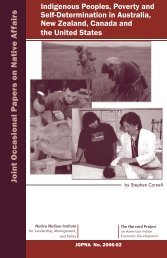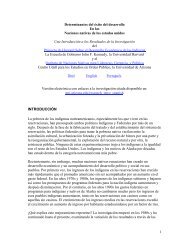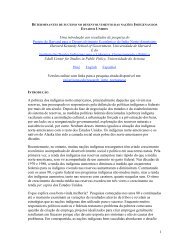American Indian Self-Determination - Native Nations Institute ...
American Indian Self-Determination - Native Nations Institute ...
American Indian Self-Determination - Native Nations Institute ...
- No tags were found...
You also want an ePaper? Increase the reach of your titles
YUMPU automatically turns print PDFs into web optimized ePapers that Google loves.
<strong>American</strong> <strong>Indian</strong> <strong>Self</strong>-<strong>Determination</strong>Stephen CornellJoseph P. Kaltnations survived as long as it has? While it certainly accords with thedemands of vocal <strong>Native</strong> leadership and activists – and one would behard-pressed to find a federally recognized tribe that would choose togo back to the era of federal management of tribal affairs – at no morethan 1.5 percent of the U.S. population, the <strong>Indian</strong> voice in nationalU.S. politics is miniscule. Moreover, with the strong push by <strong>Indian</strong>nations to control their own affairs and to be free of, particularly, stategovernment authorities, the tribes have been pushing hard againststate interests as <strong>American</strong> <strong>Indian</strong> governments build economies andgovernments that move jurisdiction, tax bases, and program fundingout of state government hands. Then, too, the general electorate inthe United States is demonstrably ill-informed as to <strong>American</strong> <strong>Indian</strong>affairs, with non-<strong>Indian</strong>s having virtually no knowledge of the legalrights of tribes and many seeing “real” <strong>American</strong> <strong>Indian</strong>s as “gone.” 31We now turn to an exploration of the political economy underlyingthe U.S. federal government’s current policies of self-determinationthrough self-government by <strong>American</strong> <strong>Indian</strong> tribes.The Sustainability of a Pro-Minority PolicyA. Introduction and ObservationsIt is our hypothesis that the survival of the U.S. federal policy of <strong>Indian</strong>self-determination through self-governance over the last four decades isrooted in a double appeal that it has for both the general electorate andtheir U.S. Congressional and Executive Branch representatives. Stateddirectly, self-determination has had enduring appeal to both <strong>American</strong>political liberals and conservatives, albeit for substantially differentreasons. <strong>Indian</strong> self-determination accords with the views commonlyfound on the liberal, or “left”, end of the U.S. political spectrum(e.g., as represented by federal officials elected as representatives of theDemocratic Party), which support relatively strongly the civil rightsof ethnic minorities and often see it as proper that such minorities becompensated for past-wrongs committed by the majority society. Atthe same time, for the conservative, or “right,” end of the U.S. politicalcontinuum (as more often embodied in the Republican Party), the descriptionsabove make it clear that <strong>American</strong> <strong>Indian</strong> self-determinationand self-governance hold appeal because of their strong components of“bootstrapping” self-sufficiency and self-reliance. Moreover, from the15







